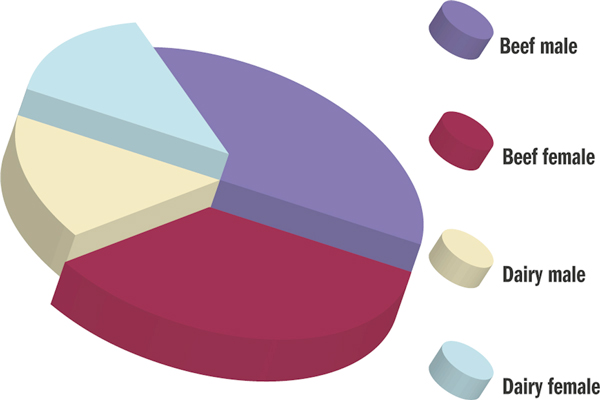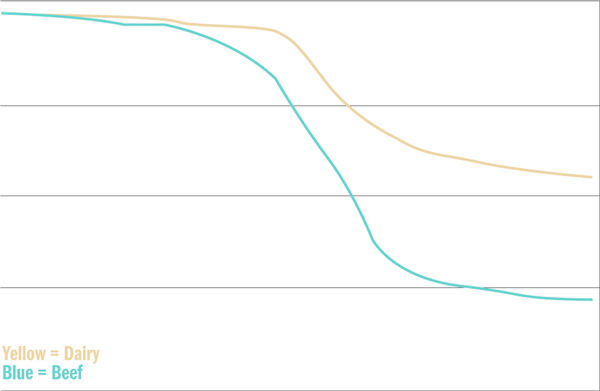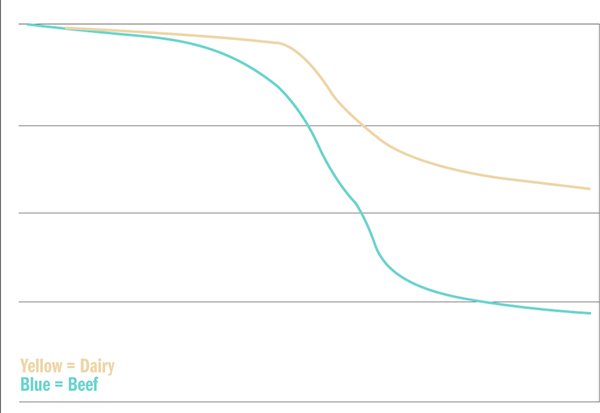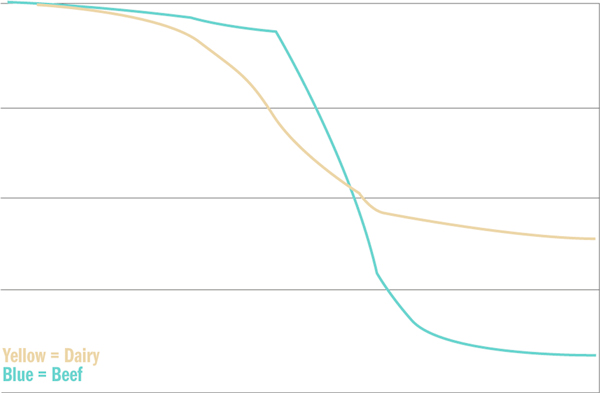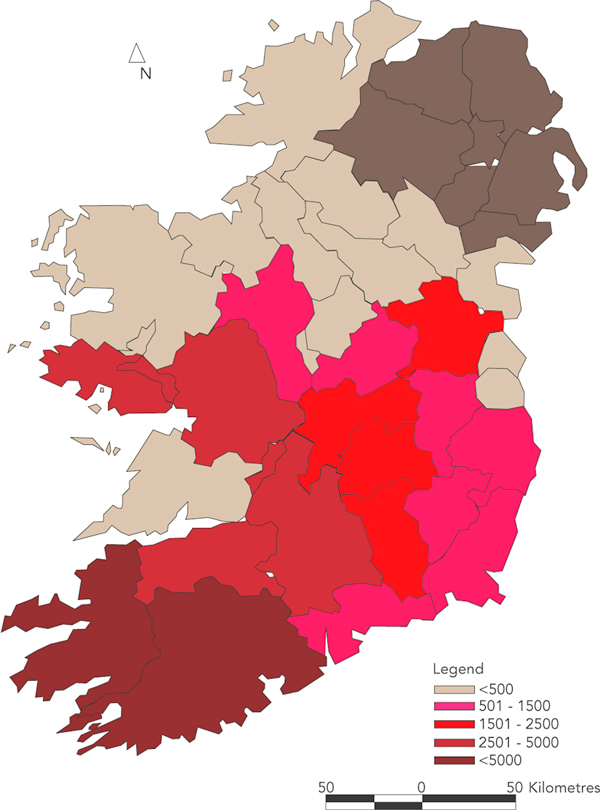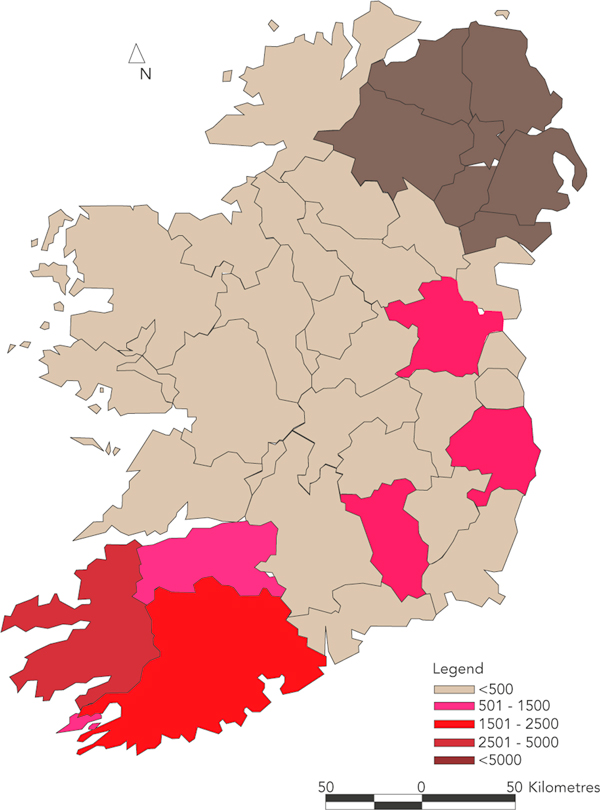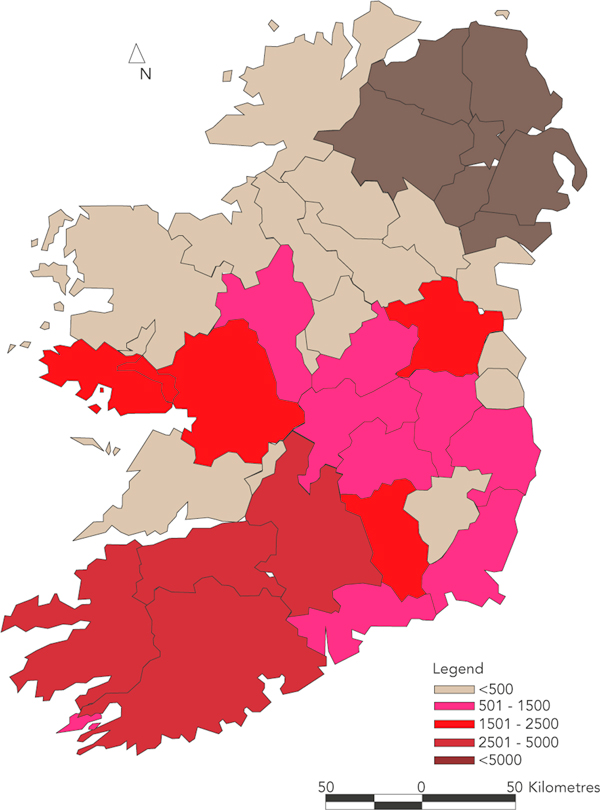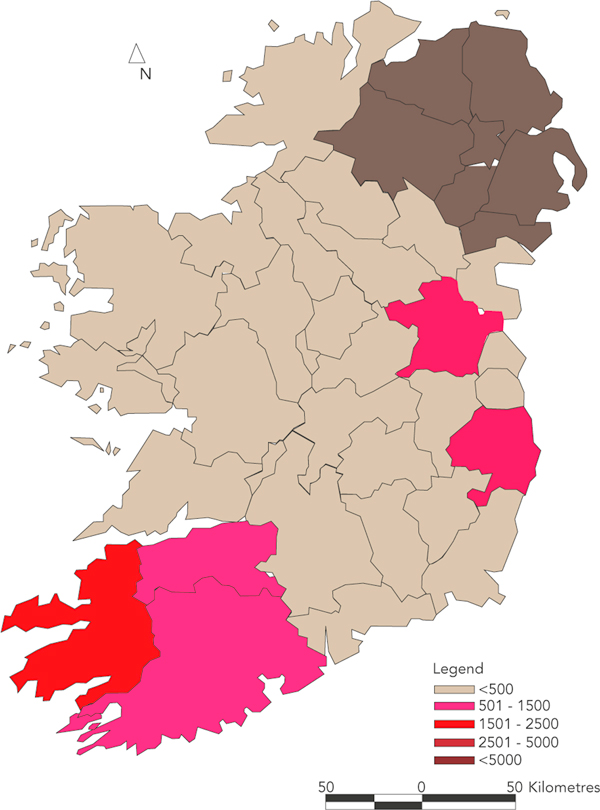Abstract
An understanding of livestock movement is critical to effective disease prevention, control and prediction. However, livestock movement in Ireland has not yet been quantified. This study has sought to define the survival and dispersal of a defined cohort of cattle born in Co. Kerry during 2000. The cohort was observed for a maximum of four years, from January 1, 2000 to December 31, 2004. Beef and dairy animals moved an average 1.31 and 0.83 times, respectively. At study end, 18.8% of the beef animals remained alive on Irish farms, including 6.7% at the farm-of-birth, compared with 48.6% and 27.7% for dairy animals respectively. Beef animals werae dispersed to all Irish counties, but mainly to Cork, Limerick, Tipperary and Galway. Dairy animals mainly moved to Cork, Limerick, and Tipperary, with less animals going to Galway, Meath and Kilkenny. The four-year survival probability was 0.07 (male beef animals), 0.25 (male dairy), 0.38 (female beef), and 0.72 (female dairy). Although there was considerable dispersal, the number of moves per animal was less than expected.
Keywords: cattle, dispersal, Kaplan-Meier, livestock, movement, survival
Introduction
The movement of animals is often implicated in the spread of disease; for example, foot-and-mouth disease [1,5], scrapie [10] in Great Britain and Johne's disease in the Netherlands [22]. Logically, effective disease prevention, control and prediction depend in part on a sound understanding of movements in relevant animal populations. For a range of diseases, studies have been conducted to define the importance of animal movement and the potential of movement in disease transmission [19,18,9,16,21,20]. Modelling studies have also been conducted to quantify the role of animal movement in disease spread [19,14,12,13,3,6,10,11] Such is the importance of disease transmission due to animal movements, new methodologies have been adapted from other areas of science, such as network analysis, in a further attempt to describe and predict disease spread [21,4,7].
To-date, no studies have been conducted to quantify the dispersal, movement and survival of Irish cattle. As a result, there is no knowledge on the potential for disease transmission as a result of these movements. The objectives of this study were to describe the movement of cattle born in Co. Kerry in 2000 in terms of dispersal, distance travelled and frequency of moves, as well as the survival of this cohort over a four-year period.
Materials and methods
Cattle production
There are approximately seven million cattle in the Republic of Ireland, including 2.2 million Friesian cows. The latter animals are used in the production of dairy products, the remainder are beef breeds producing beef for export and local consumption. The dairy herd produces five billion litres of milk per year. Counties Cork, Tipperary, Limerick and Kerry hold the largest numbers of dairy cattle, whereas counties Cork, Galway, Tipperary and Mayo have the largest numbers of beef cattle. Approximately 150,000 live cattle are exported from Ireland each year, the majority of which are beef animals. Each year, 1.6 million beef carcases are exported and 106,000 are slaughtered for domestic consumption.
The data
In Ireland, a central database is used to record the origin, identity and life history of cattle prior to death or slaughter. The database manages calf birth registrations and the Cattle Movement Monitoring System (CMMS). All cattle are uniquely identified, and farmers are obliged to maintain an on-farm herd register, which provides a record of all cattle in the holding, and to register the full details of births, (incoming and outgoing) movements and on-farm deaths. Animal movement data are also captured electronically at livestock marts, meat plants and export points. Components of the database have been operating since the 1950 s, with the system being fully-operational since January 1, 2000 [2].
The central database was accessed to identify all registered animals born on farms in Co. Kerry (one of Ireland's 26 counties) during 2000 and to access relevant data including animal identification, date of birth, sex, breed of sire, breed of dam and identification of the birth herd. In addition, we extracted data on all recorded movements prior to January 1, 2004, including date and type of movement, identification of the premises (and county) of origin and destination, and - if relevant - date of death on-farm. We considered each animal movement (farm directly to farm, farm to mart, mart to farm) as a separate event. Therefore, an animal movement between farms via a mart (Farm A to mart, mart to Farm B) was considered two separate events. Animals were considered a dairy breed if both sire and dam were Friesians, and beef otherwise.
Data analyses
The data were managed using Microsoft Access and graphs were produced using Microsoft Excel (Microsoft Corporation, Seattle, WA, USA). To create a spatial representation of dispersal, files were first prepared of each relevant livestock movement. These files included animal identification, the herd (and county) of origin, and the herd (and county) of destination. The Microsoft Access file was then converted to text format using a programme written in Microsoft Visual Basic, stored in ArcInfo and graphed using ArcView (ESRI GIS and Mapping Software, Redlands, CA, USA).
The cumulative probability of animals surviving to defined ages was determined using Kaplan-Meier survival curves, based on an analysis of time from birth to death. Data were right-censored if animals were either exported from Ireland on or prior to December 31, 2003, or were still alive on Irish farms on January 1, 2004. The survival curves were produced using Stata version 8 (StataCorp, College Station, TX, USA) following data transfer from Microsoft Access using Stat/Transfer (Circle Systems, Seattle, WA, USA). Survival curves were created for the birth cohort, in total and by breed (dairy versus beef) and sex.
Results
Survival
A total of 145,211 cattle were born in Co. Kerry during 2000, including 40,068 (27.6%; 19,650 female and 20,418 male) dairy animals and 105,143 (72.4%; 51,223 female, 53,920 male) beef animals (Figure 1). The beef animals made 138,186 (average 1.3, median 1, 25th and 75th percentiles one and two, range 0-12) movements during the four-year study period. The dairy animals moved on 33,176 occasions during this period (average of 0.8 moves per animal, median one, 25th and 75th percentiles 0 and one, range zero to seven).
Figure 1.
The relative proportion of cattle born in Co. Kerry during 2000, by production type and sex.
At the end of the study period, 19,815 (18.8%) beef animals were alive on Irish farms, including 7,000 (6.7%) animals that had never moved from their premises of birth. Of these latter animals, 5,845 (83.5%) were female. A further 64,155 (61%) beef animals were slaughtered prior to study end, 3,696 (3.5%) died on-farm and 17,477 (16.7%) were exported. During the study period, 14,068 (35.1%) of the dairy cohort were slaughtered, 1,577 (3.2%) died on-farm and 4,963 (13.2%) were exported. A total of 19,460 (48.6%) of the dairy animals survived on Irish farms until the end of the study, including 11,235 (27.7%) of all dairy animals which never moved from their premises of birth. A total of 10,755 (95.7% of these latter) animals were female. The cumulative probability of survival is presented in Table 1 and Figures 2, 3, 4. Figure 2 shows the changes in the cumulative probability of survival of the study group by production type over the study period, Figure 3 the survival of dairy cattle by sex and Figure 4 the survival of beef cattle by sex. Survival is longest in female dairy cattle (cumulative probability of surviving to four years of age, 0.72) and shortest in male beef cattle (0.07). There is a steep decline in probability of survival for male cattle between two and two-and-a-half years of age. In contrast, dairy females show a very gradual decrease in their probability of survival throughout the study period. The survival probability of dairy (Figure 3) and beef (Figure 4) male animals was similar, declining sharply between two and two-and-a-half years of age, in agreement with known industry slaughtering practices. The survival probability of female beef animals to four years of age was 0.38 (Table 1); the balance were slaughtered at an earlier age than their male counterparts (Figure 4), given that they mature earlier.
Table 1.
The probability of survival of the Kerry cohort to 1-4 years of age, including 95% confidence intervals, by production type and sex
| Survival to: |
Survival probability | ||||||||
|---|---|---|---|---|---|---|---|---|---|
| Production type | Sex | Beef | Dairy | ||||||
| Total | Beef | Dairy | Male | Female | Male | Female | Male | Female | |
| 1 year | 0.97(0.96-0.97) | 0.96(0.96-0.96) | 0.98(0.97-0.98) | 0.97(0.97-0.97) | 0.96(0.96-0.96) | 0.97(0.97-0.97) | 0.95(0.95-0.95) | 0.98(0.98-0.98) | 0.97(0.97-0.98) |
| 2 years | 0.77(0.77-0.78) | 0.72(0.72-0.73) | 0.89(0.89-0.90) | 0.81(0.81-0.81) | 0.73(0.73-0.73) | 0.80(0.80-0.80) | 0.62(0.62-0.63) | 0.83(0.83-0.84) | 0.94(0.94-0.94) |
| 3 years | 0.36(0.36-0.36) | 0.26(0.26-0.26) | 0.60(0.60-0.61) | 0.17(0.17-0.18) | 0.57(0.57-0.58) | 0.13(0.13-0.14) | 0.43(0.42-0.43) | 0.3(0.29-0.31) | 0.85(0.85-0.86) |
| 4 years | 0.29(0.29-0.30) | 0.20(0.20-0.21) | 0.52(0.51-0.52) | 0.11(0.11-0.12) | 0.50(0.49-0.50) | 0.07(0.07-0.08) | 0.38(0.37-0.38) | 0.25(0.24-0.26) | 0.72(0.72-0.74) |
Figure 2.
The cumulative probability of survival of cattle born in Co. Kerry during 2000, by production type.
Figure 3.
The cumulative survival probability of dairy cattle born in Co. Kerry during 2000, by sex.
Figure 4.
The cumulative survival probability of beef cattle born in Co. Kerry during 2000, by sex.
Dispersal
The dispersal of beef animals during the study period is presented in Figures 5 and 6. Beef cattle moved an average of 49.4 kilometres per farm-to-farm move (median 20 km, min. <1 km, 25th and 75th percentiles 7 and 49 km, max. 321 km). Dairy cattle moved an average of 44.6 kilometres per farm-to-farm move (median 19 km, min. <1 km, 25th and 75th percentiles 6 and 50 km, max. 326 km).
Figure 5.
The location, on January 1, 2002, of beef cattle born in Co. Kerry during 2000.
Figure 6.
The location, on January 1, 2004, of beef cattle born in Co. Kerry during 2000.
Discussion
Dispersal
There was substantial dispersal of cattle throughout Ireland, with dairy and beef animals from this Kerry birth cohort moving to every other county by the beginning of January 2002 (for beef animals, see Figures 5 and Figure 6). As expected, dispersal was affected by distance, with counties closer to Kerry receiving more animals than counties that were more-distant. For example, on January 1, 2002, there were 4,706 beef animals from the birth cohort in Limerick and 6,371 in Cork, in comparison to 72 and seven beef animals in the more distant counties of Monaghan and Cavan, respectively. Although no account is taken of county size (or cattle population), the general trend is clear. However, more than distance alone affects the dispersal of animals. To illustrate, fewer animals moved to Co. Clare (immediately north of Kerry across the River Shannon) than might be expected. On January 1, 2002 there were 334 beef animals from the birth cohort in Clare, and 3,016 in Galway (which is more distant). These results add weight to a widely held view of Clare as a net exporter of cattle. Conversely, Meath, a traditional cattle-fattening county in the north east of Ireland, received more cattle than any of its neighbours. The dispersal of animals throughout the country has major implications for the spread of disease [1,22,5,10]. In particular, as a result of rapid movement and widespread dispersal, there is the potential for rapid dissemination of infection prior to the development of clinical signs. Further work is needed to investigate the implications of movement on disease control in an Irish context. Mathematical modelling may be of particular benefit, specifically with the aim to predict the spread of infection following introduction. Other methodologies, such as network analysis [21,4,7] may also contribute to our understanding of livestock movements and the potential for disease spread.
Survival
Survival analysis has been used previously in Austria [8], Italy [17] and Kenya [15] to describe the changes in probability of survival of livestock. To this point, the survival experience of Irish cattle has not been quantified. The results from this work are essentially as expected, based on our knowledge of routine practices within the Irish cattle industry. The difference in survival due to production type (Figure 2) is due to the actual use of beef versus dairy cattle. Among the study population, there was a very gradual decline in survival probability among dairy cows with age, indicating their use for production purposes over a number of years (Figure 3). Dairy males on the other hand are not so long lived. Beef females, however, are less likely to be retained in the herd when compared to their dairy counterparts (Figure 4).
Extrapolation of results
Kerry has one of the largest cattle populations of any Irish county (145,211 births registered in Kerry compared with 2.1 million nationally in 2000); it was chosen as a starting point for the study of cattle movements because of this relatively large, yet manageable, number of cattle and moves, from a viewpoint of data management and manipulation. However, there are substantial regional differences in cattle management throughout Ireland, as reflected in objective measures such as the proportion of agricultural land, the density of stock, the type of land and of farms. Furthermore, severe restrictions were placed on livestock movements throughout Ireland during 2001, at the time of the foot and mouth disease outbreak. This prevented all livestock from moving for a period of time, and may have altered animal movement
Farm to fork
This study was only possible as a consequence of the national animal identification and tracing system, managed by the Department of Agriculture, Fisheries and Food. The main components of the system include calf birth registration and the cattle movement and monitoring system. The resulting database is robust, as a result of tagging and registration of all calves at birth, as well as an extensive national mechanism to trace livestock from birth to slaughter. Nonetheless, some degree of error is likely, for example data absence (animals dying before being registered) or invalidity (illegal alteration of identity as a result of ear tag swapping). These issues were not considered in the current study, and will only have a substantial effect if these errors are common.
Conclusion
The dispersal and survival of cattle in Ireland have been quantified for the first time. This data could now be used to model the spread or prevalence, and the impact of control measures, of various diseases such as brucellosis or BSE and reinforces the importance of the cattle
Movement and Monitoring System (CMMS) in ensuring both public and animal health.
Figure 7.
The location, on January 1, 2002, of dairy cattle born in Co. Kerry during 2000.
Figure 8.
The location, on January 1, 2004, of dairy cattle born in Co. Kerry during 2000. patterns subsequently. Since the end of the study period, there have also been substantial changes to the Common Agricultural Policy of the European Union. Although there remains an incomplete understanding of the effect of these changes, these reforms are certain to effect the numbers of stock kept. As a consequence of each of these issues, the Kerry results should only be extrapolated to other regions with care.
References
- Anderson I. Foot and mouth disease 2001: lessons to be learned enquiry. London, The Stationery Office; 2002. [Google Scholar]
- Anon. Irish Bovine Animal Identification and Tracing System, Computerised Database. NBAS Division, Department of Agriculture, Fisheries and Food, December 2003. 2003. http://www.agriculture.gov.ie [Accessed 12 March 2006]
- Bachmann I, Rüfenacht J, Griot C, In: Society for Veterinary Epidemiology and Preventive Medicine. Proceedings of a meeting held at Nairn, Inverness, Scotland on March 30-April 1, 2005. Mellor DJ, Russell AM, Wood JLN, editor. 2005. Assessing effectiveness of control strategies against foot-and-mouth disease in Switzerland using a dynamic simulation model; pp. 222–233. [Google Scholar]
- Bigras-Poulin M, Thompson A, Chriel M, In: Society for Veterinary Epidemiology and Preventive Medicine. Proceedings of a meeting held at Martigny, Switzerland on 24-26 March 2004. Reid SWJ, Menzies FD, Russell AM, editor. 2004. Network analysis of the Danish cattle and swine industry trade patterns as an evaluation of risk potential for disease spread: the heterogeneity issue; pp. 189–199. [Google Scholar]
- Carrique-Mas JJ, Medley GF, Green LE. In: Society for Veterinary Epidemiology and Preventive Medicine. Proceedings of a meeting held at Nairn, Inverness, Scotland on March 30-April 1, 2005. Mellor DJ, Russell AM, Wood JLN, editor. 2005. Risk of bovine tuberculosis breakdowns in post-foot-and-mouth disease restocked cattle herds in Great Britain; pp. 27–41. [Google Scholar]
- Chowell G, Rivas AL, Hengartner NW. et al. The role of spatial mixing in the spread of foot-and -mouth disease. Preventive Veterinary Medicine. 2005;73:297–314. doi: 10.1016/j.prevetmed.2005.10.002. [DOI] [PubMed] [Google Scholar]
- Christley RM, Robinson SE, Lysons R, In: Society for Veterinary Epidemiology and Preventive Medicine. Proceedings of a meeting held at Nairn, Inverness, Scotland on March 30-April 1, 2005. Mellor DJ, Russell AM, Wood JLN, editor. 2005. Network analysis of cattle movement in Great Britain; pp. 234–244. [Google Scholar]
- Essl A. Longevity in dairy cattle breeding: a review. Livestock Production Science. 1998;57:79–89. doi: 10.1016/S0301-6226(98)00160-2. [DOI] [Google Scholar]
- Forde K, Hillberg-Seitzinger A, Dargatz D. et al. The availability of state-level data on the interstate cattle movements in the United States. Preventive Veterinary Medicine. 1998;37:209–217. doi: 10.1016/S0167-5877(98)00092-0. [DOI] [PubMed] [Google Scholar]
- Gubbins S. A modelling framework to describe the spread of scrapie between sheep flocks in Great Britain. Preventive Veterinary Medicine. 2005;67:143–155. doi: 10.1016/j.prevetmed.2004.08.007. [DOI] [PubMed] [Google Scholar]
- Kitching RP, Hutber AM, Thrusfield MV. A review of foot and mouth disease with special consideration for the clinical and epidemiological factors relevant to predictive modelling of the disease. The Veterinary Journal. 2005;169:197–209. doi: 10.1016/j.tvjl.2004.06.001. [DOI] [PubMed] [Google Scholar]
- Mangen MJJ, Nielen M, Burrell AM. Simulated effect of pig-population density on epidemic size and choice of control strategy for classical swine fever epidemics in the Netherlands. Preventive Veterinary Medicine. 2002;56:141–163. doi: 10.1016/S0167-5877(02)00155-1. [DOI] [PubMed] [Google Scholar]
- Mourits MCM, Nielen M, Léon CD. In: Society for Veterinary Epidemiology and Preventive Medicine. Proceedings of a meeting held at Cambridge, UK, on 3-5 April 2002. Menzies FD, Reid SWJ, editor. 2002. Effect of control measures on the course of simulated foot and Mouth disese epidemics that started on different farm types in various Dutch areas; pp. 190–199. [Google Scholar]
- Nielen M, Jalvingh AW, Horst HS. et al. Quantification of contacts between Dutch farms to assess the potential risk of foot-and-mouth disease spread. Preventive Veterinary Medicine. 1996;28:143–158. doi: 10.1016/0167-5877(96)01042-2. [DOI] [Google Scholar]
- Ojango JMK, Ducrocq V, Pollott GE. Survival analysis of factors affecting culling early in the productive life of Holstein-Friesian cattle in Kenya. Livestock Production Science. 2005;92:317–322. doi: 10.1016/j.livprodsci.2004.08.011. [DOI] [Google Scholar]
- Rojas H, Naranjo J, Pinto J, In: Society for Veterinary Epidemiology and Preventive Medicine. Proceedings of a meeting held at Cambridge, UK, on 3-5 April 2002. Menzies FD, Reid SWJ, editor. 2002. Risk management of foot and mouth disease to prevent its introduction and dissemination in Chile from neighbouring countries; pp. 190–200. [Google Scholar]
- Samore AB, Schneider MP, Canavesi F. et al. Relationship between somatic cell count and functional longevity assessed using survival analysis in Italian Holstein-Friesian cows. Livestock Production Science. 2003;80:211–220. doi: 10.1016/S0301-6226(02)00185-9. [DOI] [Google Scholar]
- Sanson RL. The epidemiology of foot-and-mouth disease: implications for New Zealand. New Zealand Veterinary Journal. 1994;42:41–53. doi: 10.1080/00480169.1994.35785. [DOI] [PubMed] [Google Scholar]
- Sanson RL, Struthers G, King P. et al. The potential extent of transmission of foot and mouth disease: A study of the movement of animals and materials in Southland, New Zealand. New Zealand Veterinary Journal. 1993;41:21–28. doi: 10.1080/00480169.1993.35730. [DOI] [PubMed] [Google Scholar]
- Velthuis AGJ. In: Society for Veterinary Epidemiology and Preventive Medicine. Proceedings of a meeting held at Martigny, Switzerland on 24-26 March 2004. Reid SWJ, Menzies FD, Russell AM, editor. 2004. The effect of regulations on the contact structure of the Dutch cattle sector; pp. 200–215. [Google Scholar]
- Webb CR, Sauter-Louis C. In: Society for Veterinary Epidemiology and Preventive Medicine. Proceedings of a meeting held at Cambridge, UK, on 3-5 April 2002. Menzies FD, Reid SWJ, editor. 2002. Investigations into the contact structure of the British sheep population; pp. 10–20. [Google Scholar]
- Weber MF, van Roermund HJW, Assink HBJ, In: Society for Veterinary Epidemiology and Preventive Medicine. Proceedings of a meeting held at Martigny, Switzerland on 24-26 March 2004. Reid SWJ, Menzies FD, Russell AM, editor. 2004. Rate and structure of cattle transfers between cattle herds considered to be free of paratuberculosis; pp. 216–225. [Google Scholar]



